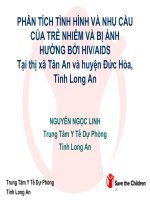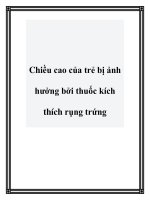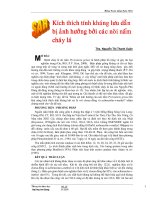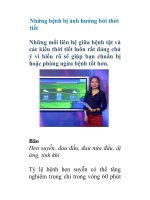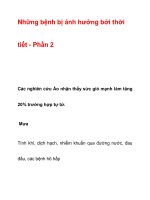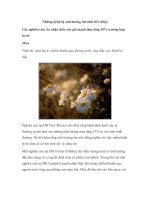FONSECA_2006_pham chat sau thu hoach bi anh huong boi do am cua bap cai
Bạn đang xem bản rút gọn của tài liệu. Xem và tải ngay bản đầy đủ của tài liệu tại đây (245.64 KB, 9 trang )
JFS
M: Food Microbiology and Safety
Postharvest Quality and Microbial Population of
Head Lettuce as Affected by Moisture at Harvest
JORGE M. FONSECA
ABSTRACT: Iceberg lettuce was evaluated for yield, microbial population, and postharvest quality either
follow- ing different irrigation termination (IT) schedules or before and after a rainfall event. Lettuce
receiving late (4 d before harvest) IT showed increased weight and diameter, higher aerobic bacteria
counts, and lower quality than plants subjected to early (16 d before harvest) IT. Middle (8 d before
harvest) IT produced similar yields, and lower microbial population in lettuce than late IT. After rain,
microbial population increased by 1.5 and 3.0 log colony-forming units (CFU)/g in outer and head
leaves respectively. The results revealed the importance of managing moisture conditions at harvest
to enhance overall quality of lettuce.
Keywords: Irrigation termination, Lactuca sativa L., shelf life, storage, yield
Int roduction
U
nderstanding the dynamic of the microbial population of
let- tuce is important for growers to deliver safe food to
consumers. Water used for irrigation of food crops is commonly not
treated and likely contains high microbial counts (Stine and
others 2005). Commonly, postharvest washing and sanitizing
methods fail to re- duce microbial populations by more than
99% (Sapers 2001), which reveals the importance of ensuring
lettuce without pathogens and with low microbial population at
harvest. Cases of illness outbreaks associated with
contaminated food have resulted in catastrophic damages to
the industry. Several outbreaks of pathogenic bacteria have
been associated with the consumption of lettuce (Kapperud
and others 1995; Acker and others 1998; Hilborn and others
1999). Increased microbial populations and higher risk of
contamina- tion are expected when vegetable surfaces are in
direct contact with irrigation water (Stine and others 2005). It
is also possible that wa- ter availability in the soil increases the
microbial population in plant tissues due to higher turgor of
plants, higher plant transpiration rate, and subsequent
moisture accumulation on the leaves surface (Coelho and
others 2005). Therefore, it is hypothesized that the longer
the term between last irrigation and harvest, the lower the
microbial population in the harvested product. Irrigation
termina- tion (IT), a concept indicative of the timing of the
last irrigation, is used to improve quality of agronomical
crops such as soybean (Heatherly and Spurlock 1993) and
cotton (McConnell and others 1999), but its impact on
vegetable quality has not been examined.
( Although early IT could yield vegetables with lower
microbial population and better quality, early IT from lettuce
fields potential- ly decreases products’ weight and affects
grower profits. In a study with broccoli, the highest quality
during postharvest storage was obtained when the plants
were subjected to water stress during the late stage of
growth ( Wurr and others 2002); however, authors found a
significant decline in yield with all the water stress treatments. The improvement in quality appears to be a result of
plants developing adaptation mechanisms to cope with
limiting factors;
MS 20050590 Submitted 9/30/05, Revised 11/9/05,
Accepted 11/17/05. The author is with Univ. of
Arizona.Yuma Agricultural Center, 6425 West 8th St. Yuma,
AZ 85364. Direct inquiries
).
to
author
Fonseca
(E-mail:
thus, plants subjected to mild stress in the field
may adapt better for subsequent stress conditions
occurring at harvest and during postharvest
storage (Galindo and others 2004).
For some applications, mild water stress does
not produce signif- icant differences in yield. With
lettuce in particular, similar yields were obtained
with 25% reduction in water availability (Gallardo
and others 1996; Coelho and others 2005).
Moreover, excess water during the growth of plants
has produced inferior quality products and higher
microbial population at harvest (Koivula and
others 2004).
The effect of moisture at harvest, either due to
IT timing or rain, on microbial quality and shelf life
of head lettuce has not been doc- umented. The
objectives of this study were as follows: (1) to evaluate the effect of different schedules of last
irrigation on microbial population of fresh iceberg
lettuce; (2) to determine the effect of IT timing on
yield and postharvest quality of fresh iceberg
lettuce; and (3) to determine the impact of
rainfall immediately before harvest on microbial
quality of iceberg lettuce.
© 2006 Institute of Food Technologists
Further reproduction without permission is prohibited
Material and Methods
Plant material and cultivation practices
Iceberg lettuce cv. Honchos II and Sahara (Seminis) were
grown during the winter season 2003-2004 and 2004-2005,
respectively, at The Univ. of Arizona–Yuma Agricultural Center
(Yuma, Ariz., U.S.A.) in an alluvial clay loam soil. Crops were
subjected to agronomical practices as currently applied in
commercial settings. Briefly, in both trials crops were
planted during October and harvested dur- ing the month of
January; fertilization included 45 kg/ha of 10-4-0- 0 at
planting followed by 3 applications of 20-0-0-17 at 50 kg/ha.
The irrigations before the last irrigation, included overhead
sprin- kling for 10 h daily during the first 5 d after planting to
establish stands, and 2 furrow irrigations, 4 and 8 wk after
planting. Accumu- lated rainfall volume during the plants’
growth was 2.1 cm for the 1st trial and 2.9 cm for the 2nd
trial. Last rainfall event occurred 19 d before harvest in the
1st trial and 12 d before harvest in the 2nd trial, which added
0.2 and 0.4 cm of water, respectively, to the soil. Relative
humidity at harvest was 35% in the 1st trial and 28% for the
2nd trial. Harvest of lettuce was conducted between 7 and
10 a.m., when temperatures ranged between 2 °C and 8 °C.
Vol. 71, Nr. 2, 2006—JOURNAL OF FOOD SCIENCE M45
Published on Web 2/15/2006
M:
Foo
d
Mic
rob
iolo
gy
&
Effect of moisture on quality of lettuce . . .
Table 1—Yields parameters of iceberg lettuce as affected by timing of the last irrigation
Irrigation termination timing (days before harvest)
Whole plant weight (g)
Head weight (g)
Head diameter (cm)
Water activity
4 OSa
1403.25
940.22
13.22
0.996
4
1406.13
952.54
13.03
0.998
8
1413.69
944.98
12.97
0.996
16
1254.93
846.70
12.73
0.995
LSD (P < 0.05)
111.79
76.48
0.45
0.0028
aOS indicates that last irrigation was conducted with overhead sprinkles; other treatments were watered with furrow irrigation. Values of plant weight are the
mean of 40 samples. Values for head weight and head diameter are the mean of approximately 180 samples.
Irrigation termination setup
The last irrigation for the 1st trial was set either 24, 16, or
6 d before harvest. These treatments resulted in soil water
content at harvest of 15.5%, 17.2%, and 17.7%,
respectively, for 0- to 30-cm depth. The 2nd trial included
treatments with IT applied 16, 8, and 4 d before harvest,
corresponding with soil water content of 14.5%, 16.2%, and
18.2%. All treatments received the same amount of water
during the season, approximately 30 cm, and were harvested the same day. Furrow was used for the last irrigation
because it is the most common method of irrigation in
Arizona; however, an overhead sprinkling treatment was also
added to the study (late IT) because it is an irrigation
method used in other regions.
The experimental site was divided into plots, each
consisted of three 182-m-long beds. Lettuce for yield,
postharvest quality, and microbial evaluations were selected
from the middle bed.
Evaluation of rain effect
The area of Yuma, Ariz., received intermittent rain during
the time of this study. Lettuce was monitored for bacteria
population 24 h before harvest and 2, 7, and 12 d after 5
rainfall events. The lettuces were selected at random from
different fields in the Yuma valley.
Yield evaluation and scoring quality systems
M:
Foo
d
Mic
rob
iolo
gy
&
Ten lettuces were selected from each plot and were
evaluated for total whole plant weight (all aboveground
tissue). A 10-m section was selected within plants of the
middle bed and all the lettuce was measured for head weight
and head diameter (equatorial). In the 2nd trial, water
activity of composite samples of the 1st 5 head leaves was
measured with a WP4-T dewpoint potential meter
(Decagon, Pullman, Wash., U.S.A.). Batches of 32 lettuces
were harvested from each plot and carried to coolers for
postharvest evaluations. The lettuces were stored at 1 °C to
4 °C and >90% rel- ative humidity. Eight heads of lettuce
were brought from coolers to laboratory for quality
examination on days 0,7, 14, and 21. With a test panel
consisting of 4 trained people (3 men and 1 woman),
general appearance, bacterial decay, and physiological
disorders of the heads were evaluated. Overall visual quality
(OVQ) was con- ducted using a 9-point hedonic scale in
which 9 was excellent quality, 7 good quality, 6 the salability point, 5 fair (becoming
objection-
T
orders was carried with a scale of incidence and severity of
any dis- order (Martinez and Artes 1999). This index ranged
from 1, indicat- ing no symptom, to 5 indicating severe
deterioration. Grade 2 was assigned to lettuce that was only
slightly affected. Grade 3 was as- sociated with salability
point, and grades 4 and 5 implied that heads were
commercially unacceptable.
Microbiological analysis
Aerobic plate count (APC) was carried out on the day of
harvest to determine the microbial load of the lettuce. For
the irrigation termination evaluation 9 heads per replicate
were taken and for the rain impact assessment a total of 20
lettuce were harvested per evaluation time. Composite
samples were taken aseptically using forceps and palette
knifes sterilized with 90% ethanol. Samples (7
g) of head leaves were diluted in 70 mL of 0.1 peptone
water
according
to
the
film
manufacturer’s
recommendation, and submit- ted to agitation using a
stomacher (Seward, London, U.K.) at 230 RPM for 45 s.
Appropriate serial dilutions were prepared, ranging from 10-1
to 10-7. Aliquots (1 mL) of the homogenate were placed onto
APC 3M-PetrifilmTM (St. Paul, Minn., U.S.A.) and incubated at
32 °C for 48 h, and the developing red colonies were
reported as colony-forming units (CFU). Colony counts were
calculated as CFU/g and then converted into log value for
statistical analysis. The inoculation of the samples was
conducted in duplicate. Samples of the experiment
conducted during the 1st y were also sent for anal- ysis to
Bio Research Laboratories, Inc. (Redmond, Wash., U.S.A.).
The bacterial analysis for the rainfall study was all conducted
at The Univ. of Arizona Vegetable Quality Laboratory.
Experimental design and statistics
The experiment evaluating the effect of IT was arranged
in a completely randomized design and each treatment
consisted of 3 replicates. Sampling of lettuce before and
after rainfall was con- ducted at random in 4 different fields
in Yuma, Arizona, using 5 plants per each of 4 replicates.
Data were subjected to analysis of variance (ANOVA) at P Š
0.05 to determine statistical significance. When ANOVA
indicated a significant difference, mean separation was
carried out by LSD test (P Š 0.05).
indication of maximum shelf life of products was when visual qualable), 3
poor, and 1 extremely poor (Artes and Martines
1996).
The
ity scores of 50% of the lettuces dropped to below 6 in the
OVQ scale. Color (L*, a*, b*) was measured to the 2nd
wrapping leaf using a MinoltaTM CR-400 chromameter (Ramsey,
URLs and E-mail addresses are active links at www.ift.org
Results and Discussion
weight and higher water activity than lettuce harvested
N.J., U.S.A.). Each mea- surement was the average of 3
readings, including 1 to the middle of the leaf stem, 1 at 1 cm
from the edge of the leaves, and 1 at 2 cm from the edge of
the leaves. Water loss during postharvest stor- age was
Vol. 71, Nr. 2, 2006—JOURNAL OF FOOD SCIENCE
M3
Effect of moisture on quality of lettuce . . .
monitored by measuring the difference in weight between
day 0 and the different periods of evaluation.
The comparison of the effect of treatments on
physiological dis-
M4 JOURNAL OF FOOD SCIENCE—Vol. 71, Nr. 2, 2006
he lettuce subjected to late IT showed higher whole plant and
head
16 d before harvest. Lettuce receiving late IT with overhead
sprin- kles also showed higher whole plant and head weight
and larger di- ameter than lettuce subjected to early IT.
Middle IT produced plants and heads with similar weight at
harvest than late IT. The lettuce subjected to early IT showed
a reduction of over 10% in head weight in comparison with
lettuce that had late and middle IT (Ta- ble 1).
The reduction of weight with the early IT treatment was
expect- ed. However, it was interesting that no difference in
weight was
URLs and E-mail addresses are active links at www.ift.org
Table 2—Effect of timing of the last irrigation on lettuce quality parameters after 7 d in storage at 2 °C to 4 °C
Irrigation termination timing (days before harvest)
Quality factors
OVQ
Decay
Water loss (%)
Brown stain
Pink rib
L*
a*
b*
4 OSa
6.60
0.80
1.5
1.5
1.1
63.74
–15.80
28.77
4
6.65
0.85
1.6
1.3
1.2
64.31
–15.68
28.54
8
6.82
0.53
1.3
1.3
1.3
63.29
–15.65
27.80
16
7.23
0.45
1.1
1.2
1.2
63.27
–15.80
28.00
LSD (P < 0.05)
0.50
ns
ns
ns
ns
ns
ns
ns
ans indicates that treatments were not different according to analysis of variance. OS indicates that last irrigation was conducted with overhead sprinkles;
other treatments used furrow irrigation. Values are the mean of 24 samples. OVQ was assessed with a 1 to 9 scale with 9 = excellent, 6 = salability point and,
1 = completely deteriorated. Brown stain and pink rib were evaluated with a 1 to 5 scale with 1 = no symptoms, 3 = salability point, and 5 = extremely
affected. Color units indicated L* = lightness, a*greenness and, b* = yellowness.
Table 3—Effect of timing of the last irrigation on lettuce quality parameters after 14 d in storage at 2 °C to 4 °C
Irrigation termination timing (days before harvest)
Quality factors
OVQ
Decay
Water loss (%)
Brown stain
Pink rib
L*
a*
b*
4 OSa
5.70
2.60
2.32
2.52
1.44
62.00
–15.80
28.35
4
5.75
2.55
2.60
2.21
1.41
61.40
–15.68
28.47
8
6.23
2.20
2.34
2.00
1.56
62.93
–15.65
27.95
16
6.4
2.20
2.02
2.03
1.41
63.00
–15.10
28.30
LSD (P < 0.05)
0.49
ns
0.56
0.42
ns
0.87
ns
ns
a ns indicates that treatments were not different according to analysis of variance. OS indicates that last irrigation was conducted with overhead sprinkles;
other treatments used furrow irrigation. Values are the mean of 24 samples. OVQ was assessed with a 1 to 9 scale with 9 = excellent, 6 = salability point and,
1 = completely deteriorated. Brown stain and pink rib were evaluated with a 1 to 5 scale with 1 = no symptoms, 3 = salability point and, 5 = extremely
affected. Color units indicated L* = lightness, a*greenness and, b* = yellowness.
observed between the middle and the late IT treatments.
Similar situation was observed in the 1st year’s trial (data not
shown). It is possible that low temperatures during the last 2
wk before harvest influenced these results by slowing down
the plants metabolism, but it was also revealed that
excessive late IT is not necessary to obtain maximum yields.
Under medium to high levels of nitrogen fertilization excess
water have produced negative results or no dif- ference in
yield volumes under similar environmental conditions to
those in this study (Sanchez 2000). A strategy used to regulate
water availability in lettuce fields, consisted in restoring soil
water con- tent to field capacity as soon as it reaches a
defined threshold (Leenhardt 1998) seems not critical for
the last irrigation of lettuce. Adequate regulated deficit
irrigation programs have increased yield of other crops such
as corn (Zhang and others 2005). Gallardo and others (1996)
suggested that in some stages of the lettuce growth,
complete water availability in the fields is not critical to
maximize yields volumes. Coelho and others (2005) recently
ob- tained maximum diameter and weight of lettuce with a
25% reduc- tion in the amount of water required to replenish
total transpiration of the plants.
Contrary to the pattern observed in the field, where higher
ben- efits were obtained with late and middle IT, a week after
posthar- vest storage, the OVQ of lettuce receiving early IT
was higher than that of lettuce subjected to late IT. The
middle IT treatment pro- duced OVQ that was not
significantly different from either early or late IT. No
differences were observed in other quality parameters (Table
2). Previously, the evaluation of quality parameters on the
day of harvest showed no differences among treatments
(data not shown).
After 14 d in storage, the OVQ of the early and middle IT were higher
than that of the 2 treatments receiving late IT. Significant
differences were also observed in L* units, brown
stain, and water loss (Table 3). The brown stain and
L* values denoted that tissue of lettuce receiving
late IT was more oxidized than that of other IT
treatments. Water loss was significantly higher in
the late IT than in the early IT. After 3 wk in
storage, water loss was also higher in the
treatment receiving late furrow IT in comparison
with early IT. At this last evaluation, the overall
quality of all treatments was low; however, decay
was highest in lettuce receiving late IT with overhead sprinkles. In addition, brown stain values
were found higher and L* lower in the late furrow
IT than in the other IT treatments (Table 4).
The influence of pre-harvest mild stress on postharvest
quality is not well understood. In several cases, vegetables
grown under more favorable conditions have resulted in
shorter shelf life. Pep- per grown in open field kept quality for
longer time than pepper grown in the greenhouse (Banara
and others 2005). Broccoli under water stress showed
increased postharvest quality (Wurr 2002). In our study, the
higher water loss rate of turgid tissue from the late IT
treatment suggests that the deterioration of quality in this
treat- ment could be associated to higher water activity and
subsequent loss of water and condensation on surface, which
resulted in an ideal scenario to accelerate microorganisms
growth and overall decay. Although microorganisms are
commonly inactivated when water activity is lower than
0.995, differences in microbial growth rate may be observed
at higher water activity levels (Fernandez- Salguero and
others 1993). Water loss immediately after harvest is a
predominant problem in most fresh vegetable applications.
High transpiration rate and subsequent water loss causes rapid
develop- ment of physiological disorders during postharvest
storage (Alferez and others 2005). Agricultural practices,
such as high nitrogen rate fertilization, that enhance turgidity
in plants often decrease shelf
M:
Foo
d
Mic
rob
iolo
gy
&
Table 4—Effect of timing of the last irrigation on lettuce quality parameters after 21 d in storage at 2 °C to 4 °C
Irrigation termination timing (days before harvest)
Quality factors
OVQ
Decay
Water loss (%)
Brown stain
Pink rib
L*
a*
b*
4 OSa
5.10
3.6
3.03
3.24
2.21
61.13
–14.70
29.90
4
5.55
2.66
3.10
3.45
2.49
60.50
–16.68
28.88
8
5.47
2.68
3.04
2.82
2.64
62.93
–15.45
28.12
16
5.72
2.60
2.80
2.75
2.45
62.87
–15.83
28.10
LSD (P < 0.05)
ns
0.74
0.27
0.54
ns
1.12
ns
ns
ans indicates that treatments were not different according to analysis of variance. OS indicates that last irrigation was conducted with overhead sprinkles;
other treatments used furrow irrigation. Values are the mean of 24 samples. OVQ was assessed with a 1 to 9 scale with 9 = excellent, 6 = salability point and,
1 = completely deteriorated. Brown stain and pink rib were evaluated with a 1 to 5 scale with 1 = no symptoms, 3 = salability point and, 5 = extremely
affected. Color units indicated L* = lightness, a*greenness and, b* = yellowness.
life, in part due to the significant reduction of stiffness
associated with loss of excess water during postharvest
storage (Newman and others 2005). Similar results, showing
early IT as the treatment with the highest quality and longer
shelf life, was observed in the 1st trial (data not shown).
The microbial population in lettuce increased with shorter
peri- ods of time between the last irrigation and harvest.
Lettuce receiving late IT had microbial counts over 0.4 log
higher than lettuce subject- ed to early IT. The microbial
population of lettuce irrigated 4 d be- fore harvest with
overhead sprinkle irrigation was particularly high- er than the
other treatments. Aerobic bacteria counts in head leaves
were higher than in outer leaves (Figure 1). These results
revealed the significant impact of moisture at harvest on
microbial population in lettuce. A recent Salmonella sp. risk
assessment re- ported different risk of infections depending
on type of crop, irriga- tion method, and days between the
last irrigation, with the latter being the factor affecting the
highest (Stine and others 2005), which coincides with this
study.
M:
Foo
d
Mic
rob
iolo
gy
&
Figure 1—Effect of irrigation termination schedule on microbial population of head lettuce. All treatments were
furrow irrigated with exception of 1 treatment (4 OS) that
was irrigated with overhead sprinkles. Bars indicate standard deviation.
The effect of rainfall on microbial population was also
evaluated. The results showed that microbial population in
lettuce heads in- creased after rain in outer and head leaves.
The increase, however, was more dramatic in head leaves,
showing a 3 log increase a week after rainfall. The outer
leaves showed an increase in microbial population of 1.5 log
in 2 d but declined after 7 d (Figure 2). The same pattern was
observed in 4 different fields from which sam- ples were
taken before and after rain (data not shown).
The results showed that rainfall occurring several d before
har- vest decreases the microbial quality of lettuce. Moisture
from rain or from overhead sprinkling likely creates an ideal
microclimate that allows native microorganisms to
proliferate and can facilitate pathogen internalization
through lesions. Contamination in the field can become a risk
of high magnitude, particularly if the micro- organism gains
access to the internal of the plant tissue through
Figure 2—Microbial population in heads and outer leaves
of iceberg lettuce after a rainfall event. Bars indicate standard deviation.
leaf lesions (Brandl and Mandrell 2002). Sprinkling water to
lettuce plants produced loss of visual quality and elevated
the risk of con- tamination (Solomon and others 2002a).
Infiltration of Salmonella sp. into growing tomatoes was
observed to increase and remained constant for 10 d (Guo
and others 2002).
The conditions for growth of bacteria on the lettuce
surface are likely more favorable on head leaves due to the
presence of a film of condensate. On the other hand, the
microbial population in out- er leaves declined more rapidly
that in head leaves due to more rapid drying and higher
impact of sun UV light, 2 factors that di- minish microbial
population (Coelho and others 2005). It is also possible that
outer leaves are subjected to intermittent water stress, which
can result in higher accumulation of metabolites that diminish bacteria growth. Abiotic and biotic factors can function as
elic- itors of defense mechanisms that induce plant
resistance to a broad array of plant pathogens (Sudha and
Ravishankar 2002; Yun and others 2002). It could be possible
that similar response occur against clinical bacteria.
Undoubtedly, an early IT can result in lower yields, but
this study showed that extremely late IT is not necessary to
maximize weight at harvest. Programs with regulated deficit
irrigation have been shown to produce similar yields
(Goldhamer and Beede 2004) and enhanced appearance
(Puiupol and others 1996). A major point revealed in this 2year study is that wet conditions at harvest result in increase
microbial population. This means that if for any reason
pathogenic bacteria reach the surface of lettuce, late IT or
rain immediately before harvest may produce ideal
conditions for proliferation of the pathogens. The survival of
microbes decline if a period of time in dry conditions is
allowed before harvest but clearly, this cannot be achieved
in times of frequent rainfall events. When wet conditions in
the field are inevitable, more rigorous con- trols of the
microbial quality are needed because efficacy of sani- tizers
is limited (Sapers 2001). Wet conditions in the soil could facilitate pathogen survival, bacteria uptake by roots, and their
migration to the head leaves (Solomon and others 2002b).
The find- ings in this study stimulate further research to
validate results with specific pathogens.
T
Conclusion
s
he results from this study showed that microbial
population in lettuce increases after rain and with late IT.
Lettuce subjected
to overhead sprinkle irrigation showed inferior visual and
microbial quality than furrow irrigated lettuce. It was revealed
that regulation of moisture at harvest through appropriate
scheduling of last irri- gation could be a practical way to
reduce microbial population of iceberg lettuce and extend
shelf life while keeping similar yields at harvest. Although the
potential decrease in weight produced with an early IT is a
concern of growers, it was shown in this study that excessive
late IT is not necessary to obtain maximum lettuce weight
at harvest.
References
Ackers ML, Mahon BE, Leahy E, Goode B, Damrow T, Hayes PS, Bibb WF,
Rice DH. 1998. An outbreak of Escherichia coli O157:H7 infections
associated with leaf
lettuce consumption. J Infect Dis 177:1588–93.
Alferez F, Zacarias L, Burns JK. 2005. Low relative humidity at harvest and
before storage at high humidity influence the severity of postharvest
peel pitting in citrus. J Am Soc Hortic Sci 130:225–31.
Artes F, Martinez JA. 1996. Influence of packaging treatments on the
keeping quality of Salinas lettuce. Lebensm Wiss Technol 29:664–8.
Banaras M, Bosland PW, Lownds NK. 2005. Effects of harvest time and
growth conditions on storage and post-storage quality of fresh-quality
peppers (Cap- sicum annuum L.) Pakistan J Bot 37:337–44.
Brandl MT, Mandrell RE. 2002. Fitness of Salmonella enterica serovar
Thomson in the cilantro phyllosphere. Appl Environ Microbiol 68:3614–21.
Coelho AF, Gomes EP, Sousa AP, Gloria MBA. 2005. Effect of irrigation level
on yield and bioactive amine content of American lettuce. J Sci Food Agric
85:1026– 32.
Fernandez-Salguero J, Gomez R, Carmona MA. 1993. Water activity in
selected high-moisture foods. J Food Comp Anal 6:364–9.
Gallardo M, Jackson LE, Schulbah K, Snyder RL, Thompson RB, Wyland LJ. 1996.
Production and water use in lettuces under variable water supply. Irrig
Sci 16:125–7.
Galindo FG, Herppich W, Gekas V, Sjoholm I. 2004. Factors affecting quality
and postharvest properties of vegetables: Integration of water relations
and me- tabolism. Crit Rev Food Sci Nutr 44:139–54.
Goldhamer DA, Beede RH. 2004. Regulated deficit irrigation effects on
yield, nut quality and water-use efficiency of mature pistachio trees
quality. J Hortic Sci Biotechnol 79:538–45.
Guo XJ, Brackett RE, Beuchat LR. 2001. Survival of Salmonellae on and in
tomato plants from the time of inoculation at flowering and early stages
of fruit de- velopment through fruit ripening. Appl Environ Microbiol
67:4760–4.
Heatherly LG, Spurlock SR. 1993. Timing of furrow irrigation termination for
determinate soybean on clay soil. Agron J 85:1103–8.
Hilborn ED, Mermin JH, Mshar PA, Hadler JL Voetsch A, Wojtkunski C, Swartz
M, Mshar R. 1999. A multistate outbreak of Escherichia coli 0157:H7
infections associated with consumption of mesclum lettuce. Arch Inter Med
159:1758–64. Kapperud G, Roervik LM, Hasseltvedt V, Hociby EA, Iversen
BG, Staveland K,
Johnsen G, Leitao J. 1995. Outbreak of Shigella sonnie infection traced to
imported Iceberg lettuce. J Clin Microbiol 33:609–14.
Koivula MJ, Kymalainen HR, Vanne L, Levo S, Pehkonen, Sjoberg AM. 2004.
Mi- crobial quality of linseed and fiber hemp plants during growing and
harvest- ing seasons. Agric Food Sci 13:327–37.
Leenhardt D, Loflie F, Bruckler L. 1998. Evaluating irrigation strategies for
let- tuce by simulation. 1. Water flow simulations. Eur J Agron 8:249–65.
Martinez JA, Artes F. 1999. Effect of packaging treatments and vacuumcooling on quality of winter harvested iceberg lettuce. Food Res Int
32:621–7.
Newman JM, Hilton HW, Clifford SC, Smith AC. 2005. The mechanical
properties of lettuce: a comparison of some agronomic and postharvest
effect. J Materials Sci 40:1101–4.
McConnell JS, Vories ED, Oosterhuis DM, Baker WH. 1999. Effect of irrigation
termination on the yield, earliness, and fiber qualities of cotton. J Prod Agric
12:263–8.
Puiupol LU, Behboudian MH, Fisher KJ. 1996. Growth, yield, and
postharvest attributes of glasshouse tomatoes produced under deficit
irrigation. Hort- Science 31:926–9.
Sanchez CA. 2000. Response of lettuce to water and nitrogen on sand and
the potential for leaching of nitrate-N. HortScience 35:73–7.
Sapers GM. 2001. Efficacy of washing and sanitizing methods for
disinfection of fresh fruit and vegetable products. Food Technol
Biotechnol 39:305–11.
Solomon EB, Potenski CJ, Matthews KR. 2002a. Effect of irrigation method
on transmission to and persistence of Escherichia coli O157:H7 on
lettuce. J Food Prot 65:673–6.
Solomon EB, Yaron S, Matthews KR. 2002b. Transmission of Escherichia
coli O157:H7 from contaminated manure and irrigation water to lettuce
plant tissue and its subsequent internalization. Appl Environ Microbiol
68:397–400. Stine SW, Song IH, Choi CY, Gerba CP. 2005. Application of
microbial risk assess- ment to the development of standards for enteric
pathogens in water used to
irrigate fresh produce. J Food Prot 68:913–8.
Sudha G, Ravishankar GA. 2002. Involvement and interaction of various
signal- ing compounds on the plant metabolic events during defense
response, resis- tance to stress factors, formation of secondary
metabolites and their molecu- lar aspects. Plant Cell Tissue Organ Cult
71:181–212.
Wurr DCE, Hambidge AJ, Fellows JR, Lynn JR, Pink DAC. 2002. The influence
of water stress during crop growth on the postharvest quality of
broccoli. Post- harv Biol Technol 25:193–8.
Yun B, Loake GJ. 2002. Plant defense responses: current status and future
exploi- tation. J Plant Biotechnol 4:1–6.
Zhang B, Li F, Huang G, Cheng Z, Zhang Y. 2006.Yield performance of
spring wheat improved by regulated deficit irrigation in an arid area.
Agric Water Manage- ment. 79:28–42.
M:
Foo
d
Mic
rob
iolo
gy
&
